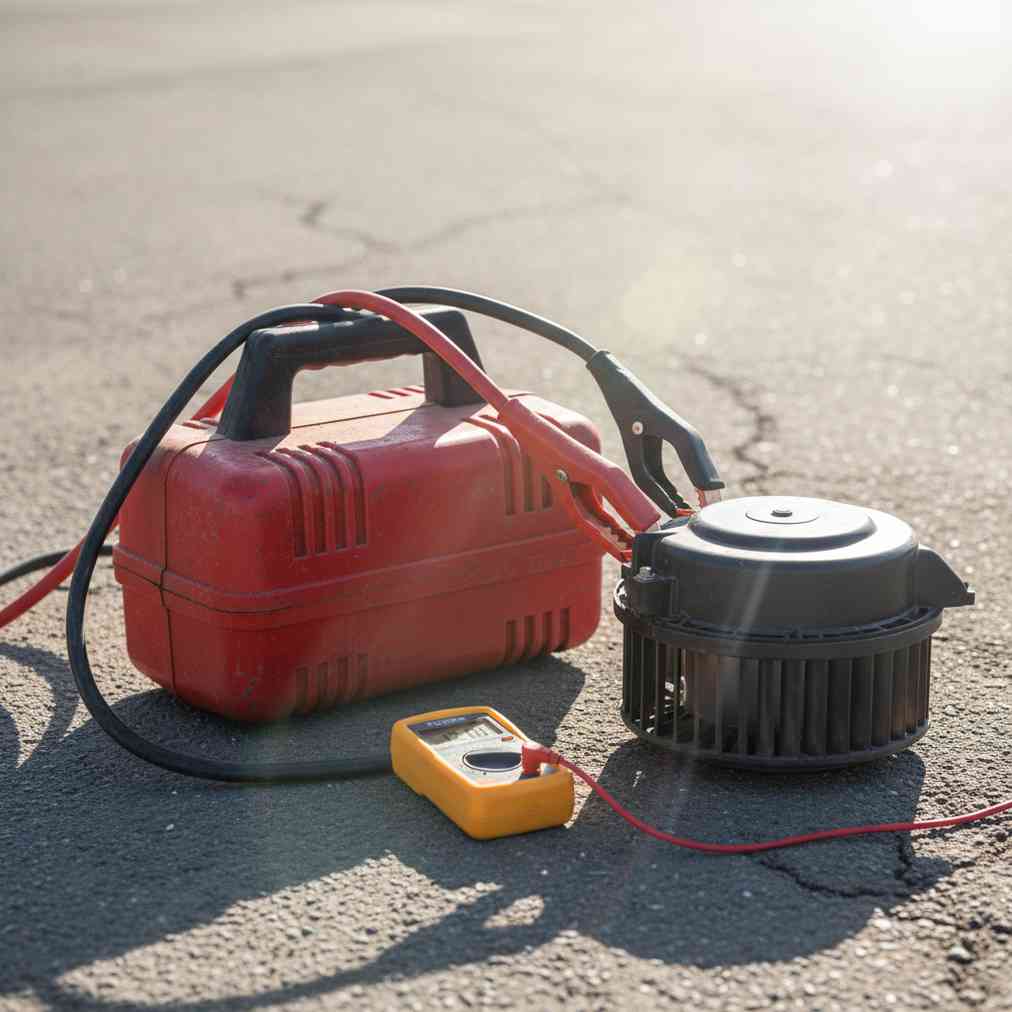Why Portable Power Testing Matters at Salvage Yards
When visiting junkyards near me, one of the biggest challenges is determining whether electronic automotive parts are functional before removing them from vehicles. Testing electronics in the yard can save you significant time and money by confirming functionality before purchase. This comprehensive guide will walk you through building or buying a portable 12V power pack and using it safely with a multimeter to test electronic parts.
Understanding Portable 12V Power Sources
The foundation of successful yard testing begins with a reliable 12V DC power source capable of delivering adequate amperage to run various automotive parts. Your power source options include several practical solutions, each with distinct advantages.
Spare Car Battery Option
A standard automotive battery provides the most robust power output and is readily available. While heavy and bulky, spare batteries offer unlimited power capacity for testing even high-draw parts like electric cooling fans. Some salvage yards may allow you to bring one for on-site testing.
Portable Jump Starter Packs
Modern jump starter packs, often called “booster boxes,” provide an excellent balance of portability and power. These rechargeable units are designed for high current delivery, though smaller models may not sustain enough amperage for demanding motors. Look for units with sustained amperage ratings rather than just peak cranking amps.
DIY Custom Power Packs
Building a custom power pack using gel-cell or LiFePO4 batteries housed in durable enclosures like trolling motor boxes creates industrial-strength testing equipment. These systems can include built-in voltage meters, accessory plugs, and sufficient capacity for extended testing sessions.
Essential Testing Equipment and Setup
Proper testing requires more than just a power source. A digital multimeter is crucial for accurate readings, as analog meters can damage sensitive electronics. Understanding the key functions will help you diagnose parts effectively.
| Function | Purpose | Expected Reading |
|---|---|---|
| Voltage (V) | Power source verification | 12V-13V for resting battery |
| Resistance (Ω) | Continuity checking | Near zero ohms = good path |
| Current (A) | Load measurement | Varies by part specifications |
Building Your DIY Testing Power Pack
Creating a custom testing station gives you maximum control over power delivery and portability. Here’s how to build an effective DIY solution:
- Enclosure Selection: Use sturdy, non-conductive boxes like plastic battery boxes or toolboxes
- Battery Choice: Deep-cycle or standard automotive batteries (Group 27 or 25) work best
- Output Terminals: Install 12V accessory sockets or heavy-duty alligator clips
- Wiring Standards: Use appropriately sized wire with proper color coding (Black for Negative/Ground, Red for Positive)
- Safety Features: Incorporate fuses near positive terminals and consider on/off switches
Safety Protocols for Yard Testing
Safety must be your top priority when working with electrical systems in salvage environments. The combination of metal surroundings, potential fluid contamination, and high-current electrical systems requires careful attention to safety protocols.
Critical Safety Rule: Never let positive and negative test leads touch each other when connected to the power source, as this will cause a short circuit, potentially damaging equipment or creating fire hazards.
- Always wear safety glasses and use insulated tools
- Verify power source voltage before connecting to parts
- Identify wire functions before applying power
- Keep a fire extinguisher nearby when working with batteries
- Disconnect power when not actively testing
Step-by-Step Testing Procedures
Systematic testing approaches ensure accurate results and prevent damage to both your equipment and the parts you’re evaluating. Modern automotive electronics incorporate sophisticated circuitry that requires careful handling and proper testing procedures.
Power Window Motor Testing
Window motors are among the most commonly tested parts in salvage yards. These bidirectional motors should operate smoothly in both directions when power and ground connections are reversed.
- Connect power to one motor lead, ground to the other
- Motor should run, moving the regulator mechanism
- Reverse polarity – motor should run opposite direction
- Check resistance between motor leads for continuity
- Listen for unusual noises indicating internal damage
Blower Motor Evaluation
HVAC blower motors are essential for climate control and defrosting systems. These high-current parts require adequate power supply for proper testing.
- Connect power to positive terminal, ground to negative terminal
- Fan should spin smoothly without hesitation
- Monitor current draw to ensure motor isn’t overloaded
- Check for proper bearing operation (no grinding sounds)
- Verify multiple speed operations if applicable
Radio Head Unit Testing
Modern automotive radios contain complex electronic circuits requiring specific power sequences. Understanding proper connection procedures prevents damage to sensitive circuitry.
- Connect power to main “BATT” wire, ground to chassis ground wire
- Some radios require “Accessory” signal for display activation
- Unit should power on and display information
- Test speaker outputs for audio signal presence
- Check voltage stability during operation
Advanced Testing Techniques
Beyond basic functionality testing, advanced techniques help identify potential issues that might not be immediately apparent. These methods can save you from purchasing parts that will fail prematurely after installation.
Load Testing vs. Continuity Testing
Understanding the difference between continuity and load testing is crucial for accurate part evaluation. While continuity testing shows that a circuit path exists, it doesn’t reveal how the part performs under actual operating conditions.
A wire or motor winding can pass a continuity test but still have high resistance under load, causing significant voltage drop during operation. This is why applying the full 12V source and observing actual function provides the definitive test results you need.
Voltage Drop Testing
Measuring voltage drop under load reveals the true condition of electrical connections and windings. High resistance connections that appear functional during low-current continuity testing will show their problems when subjected to operating current levels.
Common Electronic Parts Testing Guide
| Part Type | Power Connection | Expected Result | Common Issues |
|---|---|---|---|
| Window Motors | Power to motor leads (reversible) | Smooth bidirectional operation | Binding, slow operation, excessive current |
| Cooling Fans | Power to positive, ground to negative | Steady rotation, proper current draw | Bearing noise, blade damage, overheating |
| Fuel Pumps | Power and ground to pump terminals | Audible operation, pressure generation | No prime, irregular operation, contamination |
| Starter Solenoids | 12V to activation terminal | Audible click, plunger engagement | No click, partial engagement, contact welding |
Troubleshooting Common Testing Issues
Even with proper equipment and procedures, testing situations can present challenges. Understanding common issues and their solutions helps ensure accurate results and prevents equipment damage.
Insufficient Power Delivery
If parts don’t operate as expected, check your power source capacity. Small jump starters may not provide enough sustained amperage for high-draw parts like cooling fans or window motors. Monitor voltage during testing – significant voltage drop indicates inadequate power supply capacity.
Connector Compatibility Issues
Modern vehicles use various connector types that may not be immediately accessible for testing. Carry small probes or straightened paper clips to reach terminals within multi-pin connectors. Always identify wire functions before applying power to prevent damage to sensitive circuits.
Maximizing Your Yard Testing Success
Successful electronic testing in salvage yards requires preparation, proper equipment, and systematic approaches. The investment in a quality testing setup pays for itself quickly by preventing the purchase of non-functional parts.
When you need to sell your junk car, remember that electronic parts retain significant value even in non-running vehicles. Understanding part values and functionality helps you make informed decisions about both buying and selling automotive electronics.
Building Relationships with Yard Staff
Developing good relationships with salvage yard personnel can provide valuable insights into inventory turnover, upcoming arrivals, and testing policies. Many yards are accommodating to customers who demonstrate proper testing procedures and safety awareness.
Documentation and Record Keeping
Maintain records of tested parts, including voltage readings, current draw measurements, and operational observations. This information helps with future purchases and builds your expertise in evaluating automotive electronics. According to recent data science research, systematic documentation improves decision-making accuracy by up to 40%.
Advanced Power Pack Features
Professional-grade testing setups include additional features that enhance testing capabilities and safety. Consider incorporating these elements into your power pack design or purchase decision.
- Digital Voltage Display: Real-time monitoring of power source condition
- Circuit Protection: Fuses and circuit breakers prevent damage from shorts
- Multiple Output Options: Various connector types for different applications
- Current Monitoring: Built-in ammeters show load current in real-time
- Portability Features: Wheels, handles, and compact design for easy transport
Economic Benefits of Proper Testing
The financial advantages of thorough parts testing extend beyond avoiding defective purchases. Understanding true part condition allows for better negotiation and helps identify high-value parts that others might overlook.
Professional mechanics and DIY enthusiasts who invest in proper testing equipment report savings of 60-80% compared to purchasing new parts, while maintaining reliability through verified functionality. This approach particularly benefits those working on older vehicles where new parts availability is limited or expensive.
Future-Proofing Your Testing Setup
As automotive technology evolves, testing equipment must adapt to new challenges. Modern vehicles incorporate increasingly sophisticated electronic systems that require updated testing approaches and equipment capabilities.
Consider investing in equipment that can handle both traditional 12V systems and emerging technologies like 48V mild-hybrid systems. Recent research in automotive technology indicates that hybrid and electric vehicle adoption will significantly impact salvage yard inventory composition over the next decade.
Electric Vehicle Considerations
While this guide focuses on traditional 12V systems, electric vehicles present both opportunities and challenges for salvage yard testing. High-voltage systems require specialized training and equipment, but 12V accessory systems remain testable with conventional methods.
Conclusion: Mastering Electronic Testing in the Yard
Successful electronic parts testing in salvage yards combines proper equipment, systematic procedures, and safety awareness. Whether you build a custom power pack or purchase a commercial unit, the key is ensuring adequate power delivery and proper testing techniques.
Remember that functionality testing under actual operating conditions provides far more valuable information than simple continuity checks. Invest time in understanding proper connections, safety procedures, and systematic testing approaches to maximize your success in finding reliable used automotive electronics.
The investment in quality testing equipment and knowledge pays dividends through reduced failed purchases, better negotiating position, and increased confidence in used parts reliability. As automotive electronics become increasingly complex, proper testing skills become even more valuable for anyone working with salvage yard parts.





Leave a Reply
You must be logged in to post a comment.